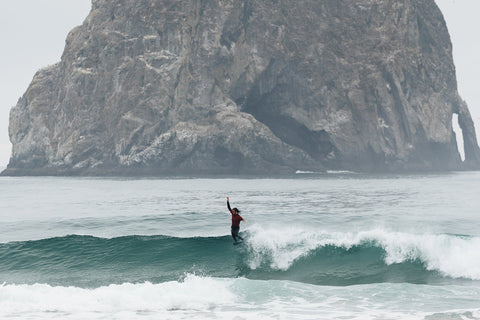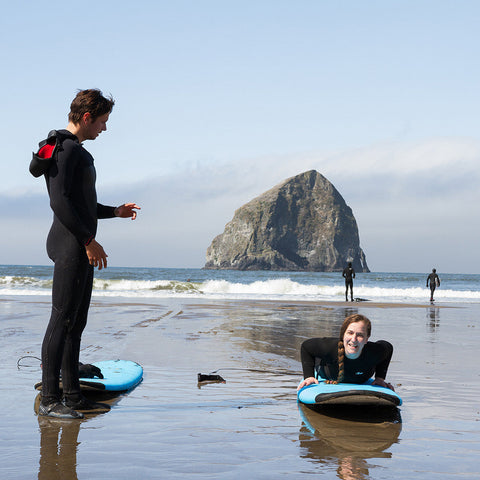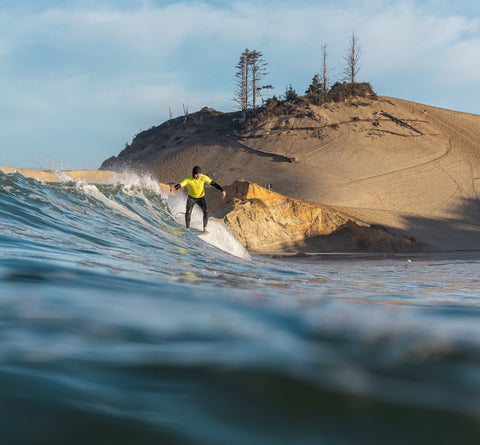Photos by Sean Fagan & Kelly Brown
“You’ve got to pay to play” or something along those lines, is what we tell ourselves whenever a board is broken during a session. When you get comfortable enough in waves that require a step-up board like Lost’s Sabo-Taj model, the likelihood of snapping it is pretty high. Extra glassing offered from many shapers can help, but it still takes just one bad wipeout or mistimed positioning to kiss your favorite PU board goodbye. So when Lib-Tech took its “dang difficult to ding” technology and combined it with Lost Surfboard’s slab hunting Sabo-Taj, could a board be born that finally holds up to heavy conditions? Let’s find out….
First things first; What makes the shape of this board so good for these conditions?
According to both of their websites: “The “Sabo-Taj” is the result of ongoing design development between Taj Burrow and Matt Biolos. Meant to perform in the widest range of conditions by minimalistic means and be a one board travel weapon for Taj. The Sabo-Taj is equally at home in powerful Indo reef waves, punchy beach breaks, compact slabs, lined up points and energized waves of any kind.
The outline features a wider than average nose with enough area under foot to be surfed fast and radical in everyday waves while the narrow tail tip holds in solid surf and barrels. The nose rocker is modest for speed and drive and the tail rocker has plenty of curve for tight radius whip and control. A slight concave between the feet adds lift but zeros out in the nose to keep things catch free and a mild double concave cuts through the tail rocker adding speed and drive. This board screams take me to Mexico or Indo all summer, Hatteras and Europe in the fall, Hawaii all winter and doesn’t mind staying close to home if it's pumping. Let’s go!”
Hard to question a board designed by one of the world’s best shapers for a surfer who is arguably one of the most progressive and fearless of all time.

Okay then, what makes Lib-Tech’s construction so different and how could it possibly hold up better during a heavy beat down?
To answer this question, it would take a bunch of cutting and pasting of information from their website because honestly, I don’t fully understand it, and I bet most of you won’t either, so you can go read everything for yourself here.
Here’s what you should know:

Lib-Tech has developed a process that is more environmentally friendly and creates a stronger construction than traditional surfboard manufacturing. It’s a combination of multiple layers of different materials that all combine into making a more durable product. I’ve personally owned several different models of theirs and can say without a doubt, they are more resilient to damage and the overall life of the board is longer. But all these were boards made for small to average size waves. What will happen when I get into larger surf? Will it be less likely to snap? Only one way to find out…
Results:
After multiple days of overhead surf, and plenty of wipeouts that could have possibly snapped traditional boards, the Lib-Tech Sabo-Taj is still going strong! In fact, the board looks as good as it did the first day I got it. This includes a session where we used a jet ski to catch waves and they are known to wreak havoc on boards. Not only that, the board performed as advertised and was an absolute blast to ride. We did find that on the larger days, setting it up as a quad fin made a big difference and held up to the faster speeds better. The board was heavy enough to deal with any chop and got down the face of waves when the offshores were blowing. However it was light under my feet and didn’t feel all that different from my traditional step-up.

Overall, I can believe it when the shaper Matt Biolos says “After years of building travel boards for quality waves, I feel like this is the best one yet.”
Will it continue to hold up and stay in one piece? I’m looking forward to finding out!










